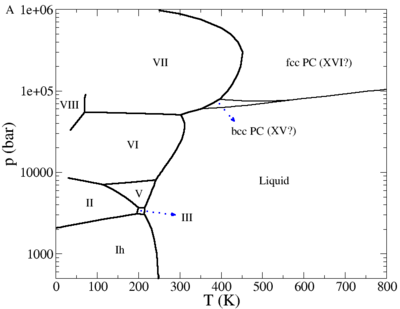TIP4P/2005 model of water: Difference between revisions
Jump to navigation
Jump to search
Carl McBride (talk | contribs) m (→Plastic crystal phases: Added a new reference.) |
Carl McBride (talk | contribs) m (Added a link to an image of the phase diagram) |
||
| Line 19: | Line 19: | ||
==Phase diagram== | ==Phase diagram== | ||
[[Image:TIP4P_2005_phase_diagram.png|right|400px]] | |||
The [[Phase diagrams | phase diagram]] of the TIP4P/2005 model is given in a publication by Abascal, Sanz and Vega. | The [[Phase diagrams | phase diagram]] of the TIP4P/2005 model is given in a publication by Abascal, Sanz and Vega. | ||
*[http://dx.doi.org/10.1039/b812832d Jose L. F. Abascal, Eduardo Sanz and Carlos Vega "Triple points and coexistence properties of the dense phases of water calculated using computer simulation", Physical Chemistry Chemical Physics '''11''' pp. 556-562 (2009)] | *[http://dx.doi.org/10.1039/b812832d Jose L. F. Abascal, Eduardo Sanz and Carlos Vega "Triple points and coexistence properties of the dense phases of water calculated using computer simulation", Physical Chemistry Chemical Physics '''11''' pp. 556-562 (2009)] | ||
Revision as of 13:15, 7 July 2009
The TIP4P/2005 model [1] is a re-parameterisation of the original TIP4P potential for simulations of water. TIP4P/2005 is a rigid planar model, having a similar geometry to the Bernal and Fowler model.
Parameters

| (Å) | HOH , deg | (Å) | (K) | q(O) (e) | q(H) (e) | q(M) (e) | (Å) |
| 0.9572 | 104.52 | 3.1589 | 93.2 | 0 | 0.5564 | -2q(H) | 0.1546 |
Phase diagram

The phase diagram of the TIP4P/2005 model is given in a publication by Abascal, Sanz and Vega.
Liquid-vapour equilibria
Plastic crystal phases
Recent simulations have suggested the possibility of a plastic crystal phase or phases for water.
- J. L. Aragones, M. M. Conde, E. G. Noya and C. Vega "The phase diagram of water at high pressures as obtained by computer simulations of the TIP4P/2005 model: the appearance of a plastic crystal phase", Physical Chemistry Chemical Physics 11 pp. 543- (2009)
- J. L. Aragones and C. Vega "Plastic crystal phases of simple water models", Journal of Chemical Physics 130 244504 (2009)
Surface tension
The surface tension has been studied for the TIP4P/2005 model by Vega and Miguel.
Self-diffusion coefficient
The TIP4P/2005 potential has a self-diffusion coefficient, in bulk water at 298 K, of 0.21 Å2 ps−1 in a classical simulation of 216 water molecules (experimental value: 0.23 Å2 ps−1).
References
Related reading




